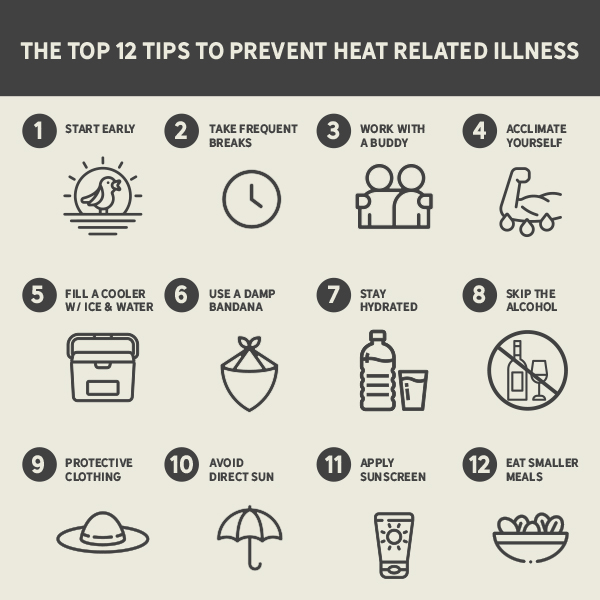

The Top 12 Tips for Working Safely in the Heat
Here in the McCoy's states, it gets hot. Really, really hot. In fact, heat is the top weather-related threat to your health. Yet, most DIYers spend a lot more time prepping their homes for the surprisingly less-likely events of floods, tornadoes, lightning, and winter storms than they do prepping themselves for hot-weather projects. And for those who make their living outside, an early heat wave may be a nasty surprise.
You can work on projects safely while it's hot. It just takes a little more planning before you begin and more awareness while you're working. And don't be fooled into thinking heat is only a factor in working outdoors, either. While outside, you do have to deal with the sun, but if you are working indoors, you also run the risk of heat problems when the temperature rises.
Here are some of the best strategies for dealing with the heat from those who sweat their way through the work week, plus a quick primer on what to do if hot weather gets the best of you.


Top 12 Tips to Prevent Heat Related Illness
If you are not accustomed to working in hot conditions, wait until cooler weather if your project allows. If your project is a repair that can't wait, try these tips:
1. Start early. Use the early morning hours just after sunrise or the late afternoon, just around sunset, to work on your project.
2. Take frequent breaks. There's no hard-and-fast rule but always err on the side of giving yourself extra time to complete projects during hot weather. Rest in the shade or air conditioning if it's available.
3. Work with a buddy. Not only does a pair of extra hands make the work go faster, you'll also be able to keep an eye on each other for signs of heat intolerance.
4. Acclimate yourself. It can take as long as 14 days or more to become accustomed to working in hot weather. Begin with just a few minutes and increase the length of time you exert yourself by no more than 20% each day.
5. Fill a cooler with ice and cold water. Even if you're working on your own property, have these close at hand to dip into whenever you need to.
6. Use a damp bandana. Wipe your face or put it around your neck. Great if you can wrap ice in it. Store extras in a plastic bag in your cooler to swap out as needed. Cooling towels are a great option, too.
7. Stay hydrated. If you're in the heat less than two hours and working moderately, drink about eight ounces of water every 20 minutes or so. If you're working longer than that, you can alternate with sports drinks containing electrolytes.
8. Skip alcohol and sugar. Some drinks can be dehydrating, and drinks with high caffeine, sugar, or alcohol content can do more harm than good.
9. Wear protective clothing. Lightweight, light-colored, and loose-fitting clothing helps to protect against heat and sun. Wear a wide-brimmed hat and sunglasses to protect your eyes--they can actually get sunburned.
11. Apply sunscreen. Put it on 30 minutes before you go outside and reapply after two hours or after excessive sweating. You probably need more than you think: two ounces (that's one shot glass full) will cover your body.
12. Eat smaller meals. Eating actually increases your body temperature. Avoid a big meal of high protein foods which are harder for your body to break down, and focus instead on vegetables and fruits high in fiber and natural juice. Take a longer lunch break to allow your body to cool down after eating.

The Signs You Aren’t Working in the Heat Safely
Heat-related issues can sneak up even on those are prepared and aware of the signs. Here the four common heat-related problems and their signs.
1. Sunburn

- Pink or red skin that feels warm to the touch
- Swelling or blisters
- Headache, fever, nausea or fatigue in combination with other symptoms
- Painful, gritty eyes
2. Heat Cramps
- Muscle spasms
- Pain in arms, legs, or stomach
3. Heat Exhaustion
- Fatigue or irritability
- Thirst
- Nausea/vomiting
- Elevated body temperature
- Rapid heartbeat
- Extreme sweating
4. Heatstroke
- Confusion
- Slurred speech
- Seizure or fainting
- Very high body temperature
- Very sweaty or very dry skin
What to Do if You’re Impacted by Working in the Heat
The number one thing to know is if you ignore signs that you’re being affected by the heat, it could lead to heatstroke. Heatstroke occurs when the body systems are overwhelmed by heat and begin to stop functioning. We sure hope it doesn't come to this!
If you suspect heatstroke
- Call 911
- Rapidly cool off with lots of cold water and/or cover with cold, wet towels or bags of ice
There are many great resources to help you identify the signs of heat-related illness and give first aid, including this one from the CDC.
Finally, if the temperature is soaring and you just don't feel "right" including feeling light-headed, overly sweaty, or not sweaty at all, stop what you’re doing and cool off. Don't let today's project get in the way of your health.
Feel free to stop by your local McCoy's for a break in the AC! We always enjoy seeing you, healthy, strong, and ready for another day, regardless of the weather.
